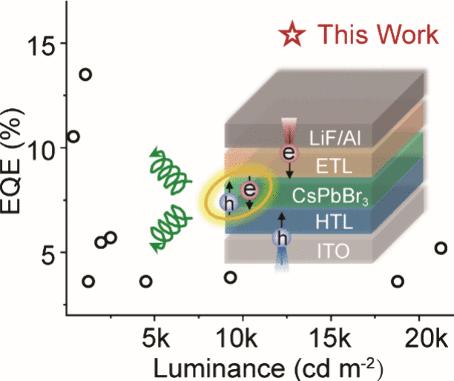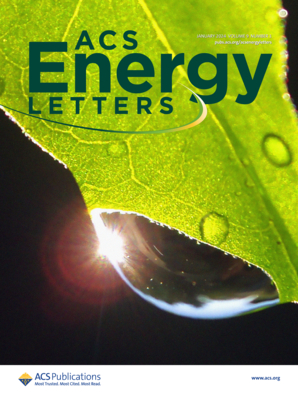Green Spin Light-Emitting Diodes Enabled by Perovskite Nanocrystals in Situ Modified with Chiral Ligands
IF 19.3
1区 材料科学
Q1 CHEMISTRY, PHYSICAL
引用次数: 0
Abstract
Spin-polarized light-emitting diodes (spin-LEDs) hold promise for next-generation technologies across optical communication, biological imaging, and quantum information processing. Chiral metal halide perovskites, which combine advantageous optoelectronic properties with chirality, are promising materials for high-performance spin-LEDs. However, such spin-LEDs still suffer from low efficiency and limited brightness, as they often rely on low-dimensional chiral perovskites with rather inferior charge-transport properties as spin filter layers. Herein, we demonstrate bright and efficient green spin-LEDs based on chiral perovskite nanocrystals as emitters. We employed an in situ chiral ligand modification using R-/S-1-(4-bromophenyl)-ethylammonium bromide to imprint chirality onto CsPbBr3 nanocrystals, which exhibited both a high photoluminescence quantum yield of 89% and improved spin relaxation lifetime. A remarkable spin-polarization of 88% was observed for the CsPbBr3 nanocrystal films. Consequently, our spin-LEDs without a commonly used spin filter layer simultaneously achieved a maximum brightness of 12,800 cd m–2, a record-high peak external quantum efficiency of 15.4%, and a circularly polarized electroluminescence with a dissymmetry factor of 2.16 × 10–3 at room temperature, setting new benchmarks for perovskite-based spin-LEDs.

利用手性配体原位修饰的 Perovskite 纳米晶体实现绿色自旋发光二极管
自旋偏振发光二极管(自旋led)有望在光通信、生物成像和量子信息处理等下一代技术中发挥重要作用。手性金属卤化物钙钛矿结合了优越的光电性能和手性,是高性能自旋led的理想材料。然而,这种自旋led仍然存在效率低和亮度有限的问题,因为它们通常依赖于低维手性钙钛矿作为自旋滤光层,其电荷输运性能相当差。在此,我们展示了基于手性钙钛矿纳米晶体作为发射器的明亮高效的绿色自旋led。采用R-/S-1-(4-溴苯基)-乙基溴化铵原位手性修饰CsPbBr3纳米晶体,其光致发光量子产率高达89%,并提高了自旋弛豫寿命。CsPbBr3纳米晶薄膜的自旋极化率达到88%。因此,我们的自旋led在没有常用自旋滤光层的情况下,同时实现了12,800 cd m-2的最大亮度,15.4%的创纪录峰值外量子效率,以及室温下不对称系数为2.16 × 10-3的圆极化电致发光,为钙钛矿基自旋led设定了新的基准。
本文章由计算机程序翻译,如有差异,请以英文原文为准。
求助全文
约1分钟内获得全文
求助全文
来源期刊

ACS Energy Letters
Energy-Renewable Energy, Sustainability and the Environment
CiteScore
31.20
自引率
5.00%
发文量
469
审稿时长
1 months
期刊介绍:
ACS Energy Letters is a monthly journal that publishes papers reporting new scientific advances in energy research. The journal focuses on topics that are of interest to scientists working in the fundamental and applied sciences. Rapid publication is a central criterion for acceptance, and the journal is known for its quick publication times, with an average of 4-6 weeks from submission to web publication in As Soon As Publishable format.
ACS Energy Letters is ranked as the number one journal in the Web of Science Electrochemistry category. It also ranks within the top 10 journals for Physical Chemistry, Energy & Fuels, and Nanoscience & Nanotechnology.
The journal offers several types of articles, including Letters, Energy Express, Perspectives, Reviews, Editorials, Viewpoints and Energy Focus. Additionally, authors have the option to submit videos that summarize or support the information presented in a Perspective or Review article, which can be highlighted on the journal's website. ACS Energy Letters is abstracted and indexed in Chemical Abstracts Service/SciFinder, EBSCO-summon, PubMed, Web of Science, Scopus and Portico.
 求助内容:
求助内容: 应助结果提醒方式:
应助结果提醒方式:


